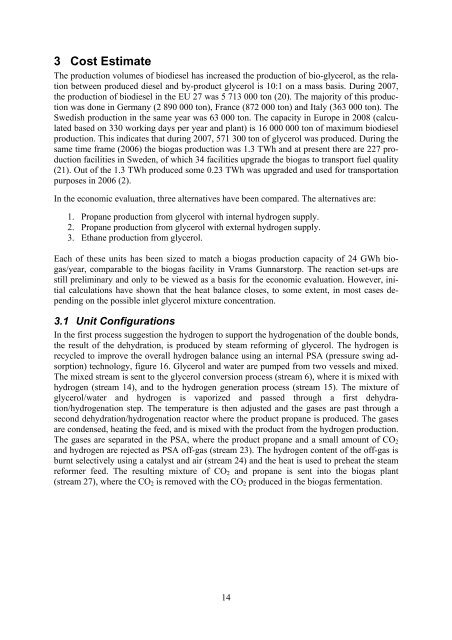Rapport SGC 198 Bio-Propane from glycerol for biogas addition
Rapport SGC 198 Bio-Propane from glycerol for biogas addition
Rapport SGC 198 Bio-Propane from glycerol for biogas addition
- No tags were found...
Create successful ePaper yourself
Turn your PDF publications into a flip-book with our unique Google optimized e-Paper software.
3 Cost EstimateThe production volumes of biodiesel has increased the production of bio-<strong>glycerol</strong>, as the relationbetween produced diesel and by-product <strong>glycerol</strong> is 10:1 on a mass basis. During 2007,the production of biodiesel in the EU 27 was 5 713 000 ton (20). The majority of this productionwas done in Germany (2 890 000 ton), France (872 000 ton) and Italy (363 000 ton). TheSwedish production in the same year was 63 000 ton. The capacity in Europe in 2008 (calculatedbased on 330 working days per year and plant) is 16 000 000 ton of maximum biodieselproduction. This indicates that during 2007, 571 300 ton of <strong>glycerol</strong> was produced. During thesame time frame (2006) the <strong>biogas</strong> production was 1.3 TWh and at present there are 227 productionfacilities in Sweden, of which 34 facilities upgrade the <strong>biogas</strong> to transport fuel quality(21). Out of the 1.3 TWh produced some 0.23 TWh was upgraded and used <strong>for</strong> transportationpurposes in 2006 (2).In the economic evaluation, three alternatives have been compared. The alternatives are:1. <strong>Propane</strong> production <strong>from</strong> <strong>glycerol</strong> with internal hydrogen supply.2. <strong>Propane</strong> production <strong>from</strong> <strong>glycerol</strong> with external hydrogen supply.3. Ethane production <strong>from</strong> <strong>glycerol</strong>.Each of these units has been sized to match a <strong>biogas</strong> production capacity of 24 GWh <strong>biogas</strong>/year,comparable to the <strong>biogas</strong> facility in Vrams Gunnarstorp. The reaction set-ups arestill preliminary and only to be viewed as a basis <strong>for</strong> the economic evaluation. However, initialcalculations have shown that the heat balance closes, to some extent, in most cases dependingon the possible inlet <strong>glycerol</strong> mixture concentration.3.1 Unit ConfigurationsIn the first process suggestion the hydrogen to support the hydrogenation of the double bonds,the result of the dehydration, is produced by steam re<strong>for</strong>ming of <strong>glycerol</strong>. The hydrogen isrecycled to improve the overall hydrogen balance using an internal PSA (pressure swing adsorption)technology, figure 16. Glycerol and water are pumped <strong>from</strong> two vessels and mixed.The mixed stream is sent to the <strong>glycerol</strong> conversion process (stream 6), where it is mixed withhydrogen (stream 14), and to the hydrogen generation process (stream 15). The mixture of<strong>glycerol</strong>/water and hydrogen is vaporized and passed through a first dehydration/hydrogenationstep. The temperature is then adjusted and the gases are past through asecond dehydration/hydrogenation reactor where the product propane is produced. The gasesare condensed, heating the feed, and is mixed with the product <strong>from</strong> the hydrogen production.The gases are separated in the PSA, where the product propane and a small amount of CO 2and hydrogen are rejected as PSA off-gas (stream 23). The hydrogen content of the off-gas isburnt selectively using a catalyst and air (stream 24) and the heat is used to preheat the steamre<strong>for</strong>mer feed. The resulting mixture of CO 2 and propane is sent into the <strong>biogas</strong> plant(stream 27), where the CO 2 is removed with the CO 2 produced in the <strong>biogas</strong> fermentation.14
















